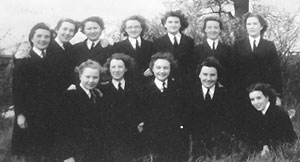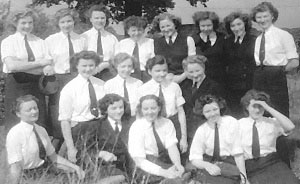|
|
|
 This site, also in the outskirts of north London at the end of an Underground line, housed a large number of Bombe machines. As at Eastcote the Wrens were quartered on the site. This was not always so at some of the other Bombe outstations. This site, also in the outskirts of north London at the end of an Underground line, housed a large number of Bombe machines. As at Eastcote the Wrens were quartered on the site. This was not always so at some of the other Bombe outstations.
Letter From Molly Green:
I was in a group of visitors to Bletchley Park on March 18th last, and when you learnt that I had worked there for most of the war, you very kindly came and showed me and a friend of mine round the old Huts 3, 6 and 8, where I had served. You expressed interest in my activities, and said that some details might be of interest to future visitors.
That's some time ago, and I would certainly have written sooner, but that on returning home (I was staying with a friend at the time of my visit) I fell ill with a very nasty bout of 'flu. Now I am recovered and feel I must write anything I recall that might be of interest.
I went to Bletchley Park in August 1941 and was sent to Hut 6, Room 5, and the "Registration Room" (see more on Hut 6 later). Right next door to us was a room full of teleprinters, manned by WAAFs.
They periodically passed the T. P. messages through to us, via a hole in the wall in a shallow box. Our job was to sort out the various traffic, some of which went immediately to other rooms, some we pigeonholed, and the greater amount we listed.
Mainly we listed the traffic that dealt with the German Air Force, the Armies, and the Railways, this latter went to Hut 8 next door.
Perhaps the details of the registration will be of interest. Each message was preceded by two groups of 3 letters, the first of which identified individual messages. A 'Foss' sheet (origin of that word unknown to me at least), on which the alphabet was written vertically and horizontally: -
ABCDEFGH
A
B1
C
DK10
E
So if a message was preceded by DBK, we would write "K" in square DB. (Vertical for first letter, horizontal for second). Each message was numbered as we listed it, so the "K" would be followed by its number on the list.
This list, on a special form devised by a Mr. Bannister (hence 'B' list or 'blist') would be assigned to a particular broadcast, and different colours were used for different broadcasts. There was red for the German Air Force, light blue and dark blue for others I've forgotten - later flowers, Primrose, Snowdrop and others, and Chaffinch, forget another - though I don't remember any other birds. (See more on Hut 6 at the end).
Of course we had to be very careful over blackout, and at nightfall somebody had to go right round the hut to inspect. It made for a rather stuffy interim, I can remember how joyfully we opened windows at the end of nightshift.
Shifts were from 9am to 4pm, 4pm to midnight and midnight to 9am. So in autumn, on the night the clocks went back, poor nightshift souls had a 10-hour shift!
Meals were prepared in the kitchen of the Mansion at first, but ultimately a bigger, specially equipped canteen was needed. I was on nightshift when we ate breakfast. The first meal ever served there. In my opinion we were very well served, food-wise. There were four phased meal breaks; for us "non-stop" workers the only possible combination was sittings 1 and 3 or 2 and 4. I can remember one hot summer when sandwiches were obtainable, very good, and lovely to eat out of doors.
Our "rough and ready" group of Huts 3, 6 and 8 was moved to a more permanent, single building in about 1943, my memory is not sure - and for us seemed delightfully spacious.
There was a group of enthusiasts who produced an entertainment every year, sketches to act, songs, dances, oblique references to events of the year. We could, of course, not invite any outside audience, which was a pity, but the home-bred audience was very appreciative of the efforts of the home-grown actors. I can remember one year the Forces did a very creditable production of "Twelfth Night".
There were, of course, people from all three services as well as us civilians. After Pearl Harbour, American officers and men came to Bletchley Park, and I remember one of them as a brilliant clown in one of our theatrical productions.
I should have said that in Hut 6 breaking of 'cribs', decoding and general breaking of codes was done, and in the Registration room we worked particularly closely with the Crib room. There was also a 'control room' where the more important and knowledgeable people worked. I can remember the following names: Mr. (later Sir) Stuart Milner-Barry, Mr. John Winton, Mr. Peter Calvocoressi (he was an occasional visitor). I thought I could remember more, but can only recall faces and voices!
I do apologise for atrocious writing and very muddled presentation!! My co-ordination generally is less and less good , if I tried to write a fair copy it would probably be as bad as this (I'm nearly 85) but don't think it's been too much effort. I've much enjoyed recalling all this, especially after years when I had to keep all this ,under my hat?. (We had to put up with a certain amount of "snide" remarks, the purport of which was: Bletchley Park ? ,Government employee ? , you mean column dodger). Not much, but one sensed it was there.
Do tell me if you would like any further clarification I'll do my best.
Personally, I think that restoring the old buildings would be a dead loss. Make a miniature "mock-up" of the whole thing, then restore the grounds would be my idea of a memorial.
Well, let me know if I can tell you any more. I did enjoy your conducted tour, so did my friend.
Yours sincerely,
(Miss) Molly M. Green

Reply from John Gallehawk, Bletchley Park Trust :
Dear Miss Green,
I am sitting on a train travelling back from Bletchley Park having just read your marvellous letter all about your time at the Park. I found it absolutely fascinating and felt I had to pen a reply straightaway although it will not be typed until tomorrow. I do hope the 'flu' malady has departed, you can do without that!
I am so amazed that you can recall as much detail after all these years. I assume that when you went to Hut 6 in August 1941, it was the wooden hut. I'm musing whether I could find your Room 5 if I can gain access. Your recall of the meals and food is useful to me. Can you remember where the specially equipped canteen was located, was it in the Mansion or just outside on what is now the car park.
I was interested in the entertainment memories, I think we have the Twelfth Night programme on display. I must check tomorrow. I've assumed that these shows were held in the Wilton Hall.
The recollection of the Foss and "blist" is, of course, especially interesting, I think these are mentioned in Gordon Welchman's book "Hut 6 Story". The six letters you mention as having been in the message heading would have been the three rotor settings showing in the letter windows on the Enigma. I wish you were at Bletchley with me because I could show you, if you did not see the machine when you visited. The second set of three would have been the message key but in enciphered form.
The idea of the Foss sheet was to put as many as you could of such keys on the sheet in the hope that they would form a cluster or grouping around the letters used for the rotor ring settings. This was because of German operator laziness in simply selecting his message key from the ring settings he had just set!
Your remarks upon the "snide" remark aura is certainly not the first time I have heard this and it cropped up again yesterday in a conversation. It must have been very hard to hear at the time, you must have been biting your tongue.
As you will have gathered I hope, I find all that you tell me to be so interesting and I use it to try to convey to visiting groups what life was really like for you heroines of the Park because I don't think that came over in the TV series.
It was a great privilege and pleasure to meet you.
What a joy to receive your letter of the 19th with all that information and sketch of Hut 6. It was by pure chance that today there happened to be one or two people looking at the situation inside Hut 6 and I saw the, normally locked door, open so I went inside for the first time ever on the very day your letter arrived. So now I must go again and see the rooms you identify - that really brings it to life. I have been in again this morning and the room numbers are still on the doors. I can appreciate the use of carbon paper, it was messy!
You have obviously remembered the BLIST and FOSS sheets and having recently come across a text with examples of the layout of these. I am enclosing copies. I've noticed that Gordon Welchman in his "Hut Six Story" describes "Herivel squares" which are identified with Foss sheets - Hugh Foss was a long serving GC and CS member. I don't think he mentions Blists.
The Light Blue key was the Operational key for Africa used in 1941.
Some of the other listening or Y-Stations nearby were Beaumanor, Whaddon, Shenley, Adstock and Gayhurst. I've also enclosed a copy of Hugh Skillen?s chart that shows all these.
I hadn't realised that Wilton Hall was built as late as 1943 so I'm grateful for that information.
My very best regards,
John Gallehawk (Archives)
P.S. The first room in Hut 6, LHS is not numbered and next door are 'loos?.
|
|
|
![]()

 This site, also in the outskirts of north London at the end of an Underground line, housed a large number of Bombe machines. As at Eastcote the Wrens were quartered on the site. This was not always so at some of the other Bombe outstations.
This site, also in the outskirts of north London at the end of an Underground line, housed a large number of Bombe machines. As at Eastcote the Wrens were quartered on the site. This was not always so at some of the other Bombe outstations.
